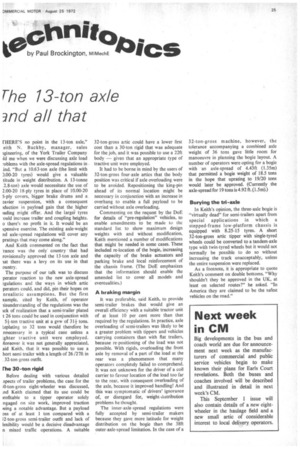The 13-ton axle 3nd all that
Page 27

If you've noticed an error in this article please click here to report it so we can fix it.
[HERE'S no point in the 13-ton axle," eith N. Buckby, manager, sales igineering, of the• York Trailer Company dcl me when we were discussing axle load oblems with the axle-spread regulations in .id. "But a 10.63-ton axle (the limit with /00-20 tyres) would give a valuable titude in weight distribution. A 13-tonne 2.8-ton) axle would necessitate the use of 2.00-20 18-ply tyres in place of 10.00-20 5-ply covers, bigger brake drums and a :avier suspension, with a consequent xluction in payload gain that the. higher lading might offer. And the larger tyres ould increase trailer and coupling heights.
there's no profit in it. It would be an tpensive exercise. The existing axle-weight ad axle-spread regulations will cover any pratings that may come along."
And Keith commented on the fact that ranee was the only country that had rovisionally approved the 13-ton axle and tat there was a levy on its use in that ountry.
The purpose of our talk was to discuss perator reaction to the new axle-spread !gulations and the ways in which artic perators could, and did, pin their hopes on nrealistic assumptions. But the first xample, cited by Keith, of operator fisunderstanding of the regulations was the ick of realization that a semi-trailer plated t 26 tons could be used in conjunction with 5+-ton tractive unit at a gvw of 31+ tons. Leplating to 32 tons would therefore be nnecessary in a typical case unless a tghter tractive unit were employed. 4oreover it was not generally appreciated, aid Keith, that it was possible to use a hort semi-trailer with a length of 26 /27ft in 32-ton-gross outfit.
rhe 30-ton rigid
Before dealing with various detailed .spects of trailer problems, the case for the .0-ton-gross eight-wheeler was discussed, nd Keith claimed that its use could be irofitable to a tipper operator solely ,ngaged on site work, improved traction wing a notable advantage. But a payload OSS of at least 1 ton compared with a I2-ton-gross semi-trailer outfit and lack of lexibility would be a decisive disadvantage n mixed traffic operations. A suitable
32-ton-gross artic could have a lower first cost than a 30-ton rigid that was adequate for the job, and it was possible to use a 22ft body — given that an appropriate type of tractive unit were employed.
It had to be borne in mind by the users of 32-ton-gross four-axle artics that the body position was critical if axle overloading were to be avoided. Repositioning the king-pin ahead of its normal location might be necessary in conjunction with an increase in overhang to enable a full payload to be carried without axle overloading.
Commenting on the request by the DoE for details of "pre-regulation" vehicles, to enable amendments to be made to the standard list to show maximum design weights with and without modification, Keith mentioned a number of modifications that might be needed in some cases. These included re-location of the bogie, increasing the capacity of the brake actuators and parking brake and local reinforcement of the chassis frame. (The DoE emphasizes that the information should enable the amended list to cover all models and eventualities.) A braking margin It was preferable, said Keith, to provide semi-trailer brakes that would give an overall efficiency with a suitable tractor unit of at least 10 per cent more than that required by the regulations. In practice, axle overloading of semi-trailers was likely to be a greater problem with tippers and vehicles carrying containers than with flat trailers, because re-positioning of the load was not possible. With rigids, overloading the front axle by removal of a part of the load at the rear was a phenomenon that many operators completely failed to comprehend. It was not unknown for the driver of a coil carrier to favour location of the load too far to the rear, with consequent overloading of the axle, because it improved handling! And this was symptomatic of drivers' ignorance of, or disregard for, weight-distribution problems he thought.
The inner-axle-spread regulations were fully accepted by semi-trailer makers because they gave more latitude for weight distribution on the bogie than the 38ft outer-axle-spread limitation. In the case of a 32-ton-gross machine, however, the tolerance accompanying a combined axle weight of 36 tons gave little room for manoeuvre in planning the bogie layout. A number of operators were opting for a bogie with an axle-spread of 4.43ft (1.35m) that permitted a bogie weight of 18.5 tons in the hope that uprating to 19/20 tons would later be approved. (Currently the axle-spread for 19 tons is 4.92 ft. (1.5m).) Burying the tri-axle In Keith's opinion, the three-axle bogie is "virtually dead" for semi-trailers apart from special applications in which a stepped-frame low-platform chassis is equipped with 8.25-15 tyres. A short 32-ton-gross artic tipper with single-tyred wheels could be converted to a tandem-axle type with twin-tyred wheels but it would not normally be possible to do so without increasing the track unacceptably, unless the entire suspension were replaced.
As a footnote, it is appropriate to quote Keith's comment on double bottoms. "Why shouldn't they be approved in the UK, at least on selected routes?" he asked. "In America they are claimed to be the safest vehicles on the road."




















































































